Lymph node homeostasis and remodeling
A review article entitled “The role of core TNF/LIGHT family members in lymph node homeostasis and remodeling” coauthored by Drs. Mingzhao Zhu and Yang-Xin Fu has been recently published on “Immunological Reviews” ( http://onlinelibrary.wiley.com/doi/10.1111/j.1600-065X.2011.01061.x/full ).
Lymph node is one of the most important lymphoid organs and distributed widely throughout the body. Lymph nodes act as filters or traps for foreign particles. They are also important in the proper functioning of the immune system. Lymph nodes maintain their structure and cellular composition during steady state, a process called homeostasis. During infection, inflammation and other pathological status, they undergo dramatic remodeling including changes in size, cellularity, lymph and blood flow, growth and activation of lymphatic vessel and blood vessel. The lymph node remodeling is believed to play pivotal roles in the regulation of immune responses. However, the cellular and molecular mechanisms of the dynamic lymph node remodeling are not well defined.
Dr. Mingzhao Zhu from Institute of Biophysics, Chinese Academy of Science and Dr. Yang-Xin Fu from the University of Chicago have been dedicated to the study on lymphoid organ development and function. Their recent collaboration has revealed an important role of LIGHT, one of the TNF superfamily members, in the control of lymph node remodeling during inflammation. ( http://www.jimmunol.org/content/186/12/7156.long ). Given their continuous and significant contribution to the field, they were invited by “Immunological Reviews” for the review article. In this article, they have systemically reviewed the role of various TNF superfamily members in the control of lymph node homeostasis and remodeling from both cellular and molecular aspects. They have depicted a comprehensive and elegant 4D model how different types of immune cells and stromal cells coordiate together through TNF superfamily members and their receptors in both temporally and spatially distinct fashion (Figure 1). Their opinions and comments would be instructive for the future direction of the study on lymphoid organ homeostasis and remodeling.

Figure 1. Dynamic regulation of lymphatic vessel and blood vessel by distinct immune cells during lymph node remodeling. Upon local stimulation, such as pathogen-associated molecular patterns, B cells and innate cells such as macrophages are activated and produce VEGF, which promotes lymphatic vessel endothelial cell and blood vessel endothelial cell growth. B cell was also suggested to deliver lymphotoxin signaling to fibroblastic reticular cells for additional VEGF production. LIGHT, another ligand of LTbR, from radioresistant cells, likely Langerhans cells, was recently found to be important for LN remodeling. Langerhans cell-derived LIGHT likely stimulates mast cells to produce TNF for lymphatic vessel remodeling. At a later stage of inflammation, differentiated Th1 and CTLs inhibit lymphatic vessel endothelial cell growth through IFN-g, leading to lymphatic vessel regression.

